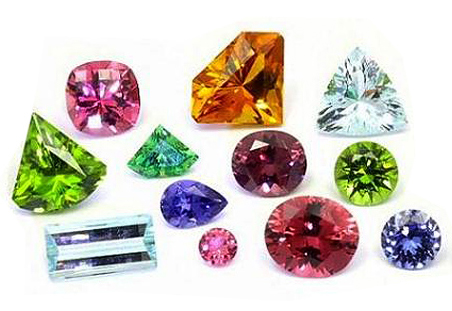
COLOR:
Color is typically the most important value-setting factor for gemstones. All gems have a preferred color or a relatively small range of preferred colors. The more the color varies from this range—lighter or darker, more vivid or less—the less valuable the stone.
Color is composed of three dimensions: hue, tone, and saturation.
Hue refers to the impression of color usually noticed immediately, such as red, yellow or blue.
Tone refers to the degree of lightness or darkness of an object.
Saturation defines the degree of purity of a hue.
CUT:
Cut refers to the shape or design of a stone, arrangement of facets, as well as the precision of the stone's proportions and finish. The cutting process reveals the beauty of a gem.
Gemstones are cut into shapes we are familiar with such as oval, emerald, pear, round, and marquise. In addition, they can be carved or fashioned into almost any design imaginable. Proportions involve the balance and appeal of the basic design. Finish refers to the detail of the workmanship. A well-proportioned cut with a fine finish will show a stone's optical properties to its fullest potential. When all other factors are even (color, clarity, and carat weight), a better-cut gem will be more valuable.
CARAT WEIGHT:
The size of a gemstone is measured, not by its dimensions, but by weight. One carat, the traditional unit of measurement for gemstones, is equal to approximately 0.2 grams. You may also hear the weight of a gemstone referred to in points. A point is equal to 1/100 of a carat; therefore a 75-point gemstone equals 0.75 carat.
Two different gemstones may have the same dimensions but different weights. This is due to the specific gravity or density of the gem mineral. This difference can help gemologists identify a gemstone.
Up to a certain point, the larger a stone is, the more rare it is and the higher the price it will command. For stones that commonly occur in larger sizes, the value may decrease if the gem reaches a size that makes it impractical for jewelry use.
Source: Gemological Institute of America.
CLARITY:
A gemstone's clarity grade is directly related to its rarity. Clarity refers to a gemstone’s relative freedom from clarity characteristics. Clarity characteristics include inclusions, which lie within the stone, or blemishes, which lie on the surface of a gem. The fewer clarity characteristics, the more rare the gemstone.
Each variety of gemstone has its own clarity standards. For example, Tanzanite is virtually inclusion-free, while Emerald almost always contains clarity characteristics. For this reason, Gemological Institute of America's grading system divides transparent colored gemstones into three clarity types. This allows gems to be more evenly evaluated as it takes into account the individual nature of each gemstone. Each type is further divided into five grading descriptions.
CLARITY TYPES:
Type I gems are often virtually free of clarity characteristics. The stones most commonly seen in the market include:
Aquamarine
Green Tourmaline
Morganite
Smoky Quartz
Green Tourmaline
Tanzanite
Topaz – Blue
Zircon – Blue
Type II gems normally contain clarity characteristics. The stones most commonly seen in the market include:
Alexandrite
Garnet
Zircon – Green
Amethyst
Iolite
Sapphire – all colors
Zircon – Orange
Ametrine
Peridot
Spinel - all colors
Zircon - Red
Citrine
Ruby
Tourmaline
Zircon - Yellow
Type III gems almost always contain clarity characteristics. These include:
Emerald
Tourmaline – Watermelon
CLARITY GRADES:
Type I: Usually eye-clean with no clarity characteristics visible to the unaided eye.
Type II: Typically shows some eye-visible clarity characteristics that do not detract from the overall beauty of the gem.
Type III: Almost always contain eye-visible clarity characteristics.
